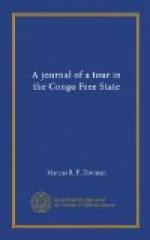On Sunday we lunched with the Governor General, Mr. Gohr, the Director of Justice—who at present is in the unenviable position of having many critics in Europe, usually imperfectly informed of the details and evidence laid before the judges—Mr. Vandamme, who knows everyone and everything connected with the State, Commandant and Madame Sillye, Judge and Madame Webber, and some others. Afterwards, Mr. Webber, the Judge of the Court of Premiere Instance, who is an excellent pianist, gives us proof of his talent. This is the last pleasant music we are fated to hear for many a month, for nothing but concertinas and gramophones are found in the interior.
[Illustration: THE CATARACTS RAILWAY NEAR MATADI.]
Having obtained bundles of permits to do various things, and arranged for letters and parcels to be sent after us into the interior, we left Boma on the morning of July 19th for Matadi in the Leopoldville.. The Congo just above Boma somewhat resembles the Highlands of Scotland, and the similarity was emphasised by the fact that it was raining hard. The hills were bare of trees, the current ran rapidly, forming whirlpools, while many sleepy crocodiles lazily flopped into the water as we passed. After ascending some twenty miles, the river turns sharply to the right and runs between cliffs which descend sheer into the water, forming a narrow chasm not more than half a mile broad. As the whole of the immense volume of water in the Congo has to pass through this gorge, it is enormously deep and the current is very rapid. The depth has not been accurately ascertained, but it is certainly 500 feet, if not more, and the flow of the water is at the rate of nearly ten knots an hour, so that the smaller steamers cannot ascend at all, and the larger only creep slowly up.
[Illustration: THE RAILWAY STATION AT MATADI.]
Matadi is soon after in sight. It is built on the south side of the Congo valley, for, as a glance at the map will explain, the State owns both banks at this point, but further up, the river becomes the frontier with the French Congo. Matadi is an ancient—if the word may be used in connection with the Congo at all—settlement, constructed at the point where navigation on the river is interrupted by cataracts and rapids for some two hundred miles until smooth water is reached again at Stanley Pool. A caravan route runs from Matadi to Leopoldville, and it was during the march of twenty days over the mountains that in the early days, so much trouble was occasioned by the native porters. All this is abolished now by the railway. The town itself stands on the side of a steep hill and consists of narrow streets paved with cobbles. Here as usual in the Congo, man is restricted to his primeval method of locomotion. Two iron piers jut into the stream and at their ends the European steamers discharge their cargoes into the railway trucks alongside. High up on the hill stands a capacious stone structure, the house




